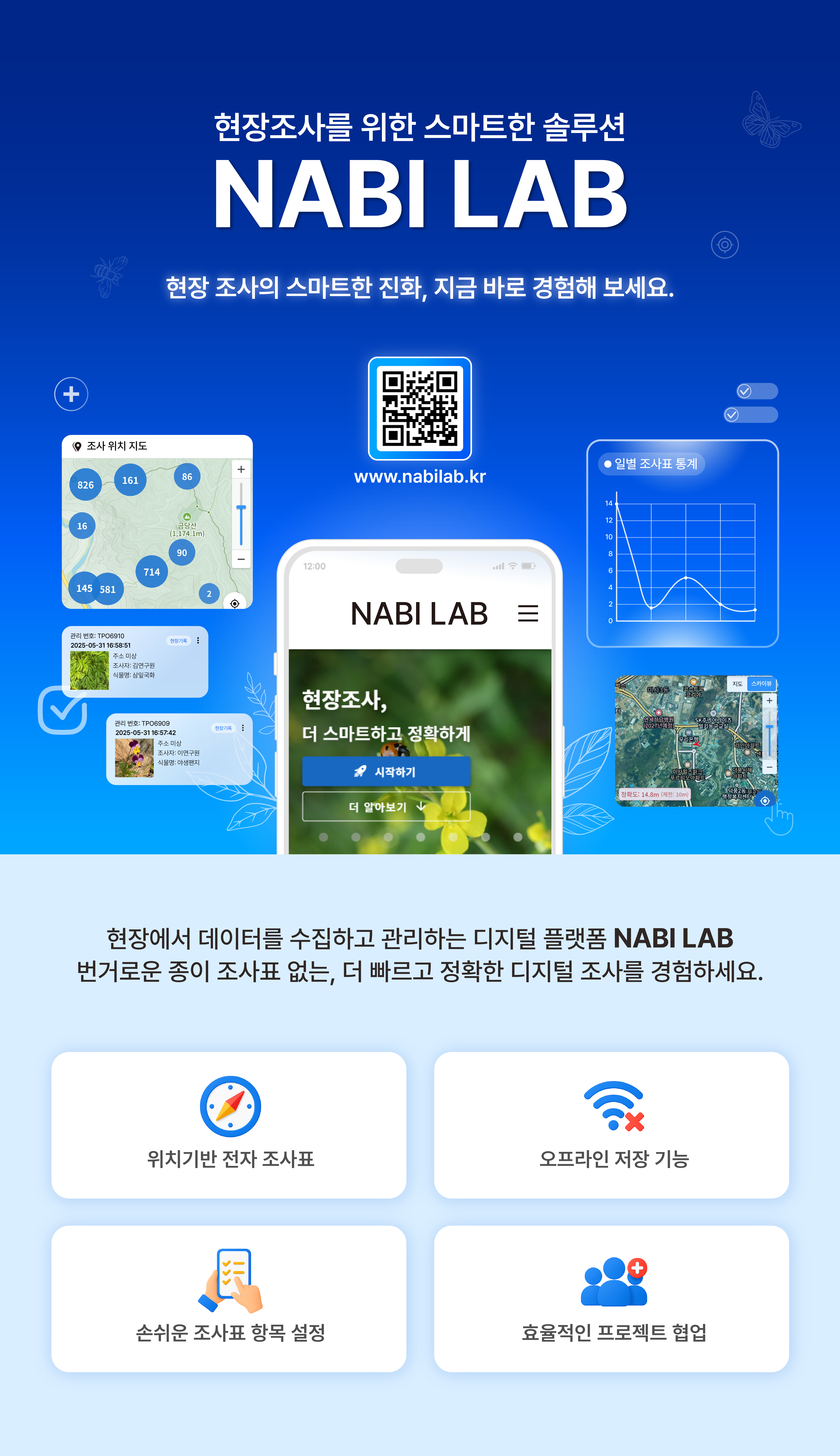List of Vascular Plants of the Korean Peninsula
What is the NABI List of Vascular Plants of the Korean Peninsula?
 The Northeastern Asia Biodiversity Institute’s List of Vascular Plants of the Korean Peninsula is intended to minimize confusion by standardizing the use of common and scientific names of vascular plants in Korea.
Built based on The Genera of Vascular Plants of Korea (Flora of Korea Editorial Committee, 2007) 1), National Species List (National Institute of Biological Resources) 2), and Korean Plant Names Index (Korea National Arboretum) 3),
the NABI List of Vascular Plants of the Korean Peninsula comprises the common and scientific names of 4,425 native vascular plant taxa and 1,102 introduced vascular plant taxa including naturalized and cultivated species. Ten individual lists4) of species of special interest or concern (e.g., endangered species) are also available.
The Northeastern Asia Biodiversity Institute’s List of Vascular Plants of the Korean Peninsula is intended to minimize confusion by standardizing the use of common and scientific names of vascular plants in Korea.
Built based on The Genera of Vascular Plants of Korea (Flora of Korea Editorial Committee, 2007) 1), National Species List (National Institute of Biological Resources) 2), and Korean Plant Names Index (Korea National Arboretum) 3),
the NABI List of Vascular Plants of the Korean Peninsula comprises the common and scientific names of 4,425 native vascular plant taxa and 1,102 introduced vascular plant taxa including naturalized and cultivated species. Ten individual lists4) of species of special interest or concern (e.g., endangered species) are also available.
The taxonomic position of taxa within the order, family, and genus follows APW (Angiosperm Phylogeny Website, version 14) 5). The vascular plants are divided into lycophytes, ferns, gymnosperms, and angiosperms; the angiosperms are further classified into five groups: basal angiosperms, magnoliids, eudicots, ceratophyllales, and monocots. Genera and species are presented in alphabetical order.
Scientific names of taxa belonging to the ranks including and below species have been verified against The International Plant Names Index6), World Checklist of Selected Plant Families7), Tropicos8), and The Plant List9). Author names follow the IPNI Author Standard Form. Note that some of the names in the list may not be up to date or may be invalid. These names are currently being reviewed.
In the case of multiple common names, priority is given to the earliest published and the most well-known, given that the name is in grammatical Korean and is not vulgar. Note that the determination process is still in progress and the list will be continually updated as relevant studies are carried out.
The Northeastern Asia Biodiversity Institute’s List of Vascular Plants of the Korean Peninsula encompasses the common and scientific names of 5,527 vascular plant taxa recorded in the Korean Peninsula. However, be informed that the list also includes infraspecific taxa and species inquirenda and incertae sedis.
Recent studies have put an end to the perennial debate over the origin of cherry blossom by categorizing Korean cherry blossom and Japanese cherry blossom as two distinct species. Each species was since assigned a common and scientific name: Prunus × nudiflora (Koehne) Koidz. (wangbeojnamu; 왕벚나무) and Prunus × yedoensis Matsum. (someiyoshinobeojnamu; 소메이요시노벚나무). It should be noted that while Prunus × yedoensis Matsum. (someiyoshinobeojnamu; 소메이요시노벚나무) is commonly seen around the world, Prunus × nudiflora (Koehne) Koidz. (wangbeojnamu; 왕벚나무) is a rare species endemic to Jeju Island.
Please feel free to distribute this list as you see fit and make any changes you deem appropriate. If you have any questions or suggestions, leave a comment and help us build a better list(jungjongduk@gmail.com).
References
- 1) Flora of Korea Editorial Committee (2007) The Genera of Vascular Plants of Korea. J. W. Park ed.
- 2) National Institute of Biological Resources (2018) National Species List.(Act on The Conservation and Use of Biological Diversity Article 10)
- 3) Korea National Arboretum (2018) Korean Plant Names Index
- 4)
- a. Endangered Species of Plant: Attached Table 1 of the Enforcement rule of the Wildlife Protection and Management Act
- b. Ecosystem Disturbing Species: Notification No. 2020-61 of the Ministry of Environment
- c. Rare Plants: Attached Table 1-3 of the Enforcement Rule of the Act on the Creation and Furtherance of Arboretums and Gardens
- d. Exotic Plants: Kang, E. S., S. R. Lee, S. H. Oh, D.-K. Kim, S.-Y. Jung, D. C. Son (2020) Comprehensive review about alien plants in Korea. Korean Journal of Plant Taxonomy 50: 89-119
- e. Korean Endemic Plants: Chung, G. Y., K. S. Chang, J. Chung, H. J. Choi, W. Paik, J. Hyun (2017) Korean Endemic Plant. Korean Journal of Plant Taxonomy 47: 264-288
- f. Climate-sensitive Biological Indicator Species: National Institute of Biological Resources (2010) Korean Climate-sensitive Biological Indicator Species
- g. Plants Adaptable to Climate Change: Korea National Arboretum (2010) 300 Target Plants Adaptable to Climate Change in the Korean Peninsula
- h. Korean Red List of Threatened Species: National Institute of Biological Resources (2012) Red Data Book of Endangered Vascular Plants in Korea
- i. Biological Resources Subject to the Approval of Outbound Transfer: Notification No. 2016-184 of the Ministry of Environment
- j. Floristic Target Species: Kim, C. H. et al. (2018) Floristic Target Species (FT species) in Korea. National Institute of Ecology
- 5) Stevens, P. F. (2001 onwards) Angiosperm Phylogeny Website. Version 14, July 2017 [and more or less continuously updated since]
- 6) IPNI (http://www.ipni.org)
- 7) WCSP (https://wcsp.science.kew.org)
- 8) Tropicos (http://www.tropicos.org)
- 9) The Plant List (http://www.theplantlist.org)

